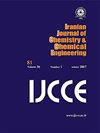水热法获得的硬硅橄榄岩的形态结构表征和电泳沉积
IF 1.3
4区 工程技术
Q4 CHEMISTRY, MULTIDISCIPLINARY
Iranian Journal of Chemistry & Chemical Engineering-international English Edition
Pub Date : 2021-11-09
DOI:10.30492/IJCCE.2021.131277.4241
引用次数: 0
摘要
本研究采用水热法在Si-Ca-Na-H2O体系中合成了硅钙石。利用XRD技术对所得材料进行了详细的结构表征,结果表明所得材料中含有少量的硅灰石(高达3%)作为杂质。所得样品在900℃下煅烧,硅灰石完全转变为硅灰石,硅灰石仅为晶体相。采用Scherrer和Williamson-Hall方法计算了各晶相的晶粒尺寸和晶格应变。扫描电镜观察软橄榄岩的形态,发现微小的针状晶体连接在一起形成树枝状或球状聚集体。通过选择合适的电场强度、分散介质和分散剂,获得了硬硅石在304不锈钢上电泳沉积的最佳条件。以含1%水的异丙醇为分散介质,硝酸钙为加料添加剂,获得了稳定的悬浮液。天然硅钙石层具有非常光滑的形貌,而煅烧后,涂层中可以观察到小裂纹的出现,但涂层与基体的附着力得到提高。本文章由计算机程序翻译,如有差异,请以英文原文为准。
Morpho-structural characterization and electrophoretic deposition of xonotlite obtained by a hydrothermal method
In this research, xonotlite was synthesized by a hydrothermal method in the Si-Ca-Na-H2O system. Detailed structural characterization by using XRD technique revealed that obtained material contains a small quantity of wollastonite (up to 3 %) as impurity. Calcination of the obtained sample at 900 ˚C has resulted in complete transformation of xonotlite to wollastonite which was detected as only crystal phase. Crystallite size and lattice strain of all crystal phases were calculated using Scherrer and Williamson-Hall method. SEM observation of xonotlite morphology revealed tiny needle-like crystals joined together forming dendritic or globular aggregates. Optimal conditions for electrophoretic deposition of xonotlite on 304 type stainless steel have been achieved by appropriate selection of electric field strengths, dispersing medium and dispersants. Stable suspension of material was obtained using isopropanol containing 1 % water as dispersing medium and Ca-nitrate as charging additive. Native layers of xonotlite have a very smooth morphology, while after calcination, the appearance of small cracks in the coating can be observed but the adhesion strength of the coatings to the substrate is improved.
求助全文
通过发布文献求助,成功后即可免费获取论文全文。
去求助
来源期刊

Iranian Journal of Chemistry & Chemical Engineering-international English Edition
CHEMISTRY, MULTIDISCIPLINARY-ENGINEERING, CHEMICAL
CiteScore
2.80
自引率
22.20%
发文量
0
审稿时长
6-12 weeks
期刊介绍:
The aim of the Iranian Journal of Chemistry and Chemical Engineering is to foster the growth of educational, scientific and Industrial Research activities among chemists and chemical engineers and to provide a medium for mutual communication and relations between Iranian academia and the industry on the one hand, and the world the scientific community on the other.
 求助内容:
求助内容: 应助结果提醒方式:
应助结果提醒方式:


